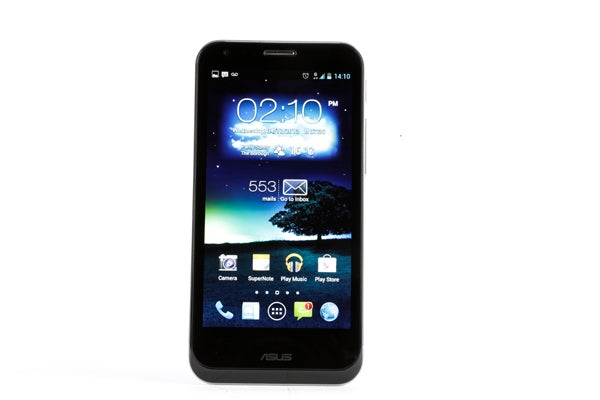Asus Padfone 2 Review
Asus Padfone 2
It's a phone and tablet hybrid, but does it have a point?

Verdict
Pros
- Unique two devices in one hybrid
- Decent phone
- Speedy processor
- Good battery life
Cons
- Expensive
- Poor tablet screen
- Can only use one device at a time
Key Specifications
- Review Price: £600.00
- 4.7in 720p IPS Plus phone screen
- 1.5GHz Snapdragon S4 quad-core CPU with Adreno 320 graphics
- 10.1in 1280 x 800 IPS tablet screen
- 2GB RAM, 32-64GB of storage
What is the Asus Padfone 2?
The Asus Padfone 2 is an Android phone that can be slotted into a tablet-like dock called the Padfone 2 Station. It’s a hybrid device – a top of the range smartphone that, with one easy movement, becomes a 10.1-inch tablet.
At first glance it makes sense. You’ll rarely be using a phone and tablet at the same time so why spend money on two different devices when you can use one to power the other? With a quad-core Snapdragon processor and 2GB RAM there’s more than enough under the hood. But can the Padfone 2 really provide the best of both the phone and tablet experiences? 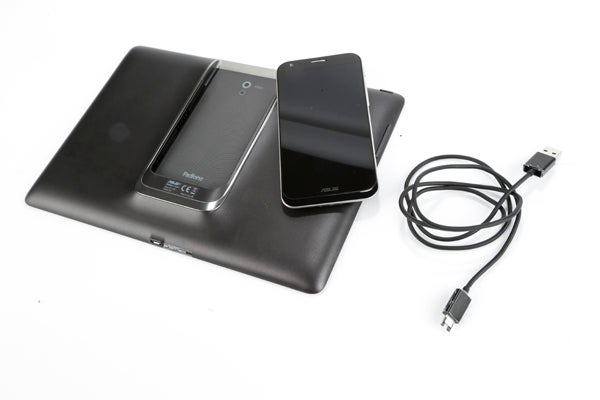
Asus Padfone 2 – Design and build quality
To use an old footballing cliché, this will be a review of two halves. On the one hand we have a very high spec 4.7-inch phone and on the other we have a 10.1 inch tablet. For this reason we’ll split the review into more manageable sections.
Phone
The Padfone 2 phone is one of the best-specced phones on the market, and it also shows off the great build quality we’ve come to expect from Asus products. 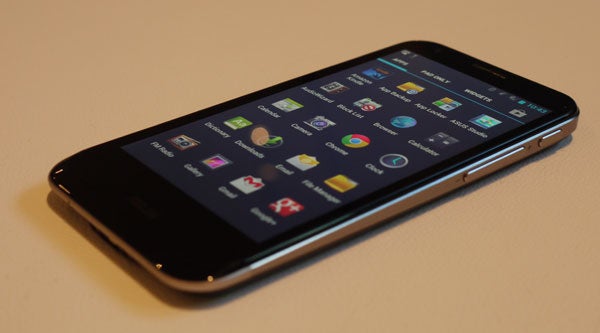
It’s quite reminiscent of a black iPhone 4S – a good thing. A silvery metal trim surrounds the phone, with a metal SIM-card holder at the top, next to a 3.5mm headphone jack.
The trim makes the Asus Padfone 2 look and feel like a premium phone but it’s all slightly spoiled by a plastic section at the bottom of the phone that tries, but fails, to look like a continuation of the metal. This stops the antenna from shorting, but it’s not an elegant solution.
The body tapers slightly from top to bottom, which makes it much easier to hold and reach those corners that can be a bit tricky to get to on larger phones. At 136g it’s not too heavy, but neither is it too light, a common complaint made about the iPhone 5.
Once you turn it onto its black hard plastic back the Padfone 2 phone looks even better. The camera is centred near the top of the phone, with the LED flash sitting below it and a speaker grille just to the right. It even makes a design statement with a series of concentric ridges that spread out from the camera.
Not only does this separate the Padfone 2 phone from most of its competitors, it also provides an extremely solid grip. It’s different but we like it. The one thing that spoils the line is the micro-USB socket, which juts out a little too far.
Oddly the phone’s back is removable but as there no microSD card slot inside and you’re not supposed to change the battery yourself there hardly seems any point. 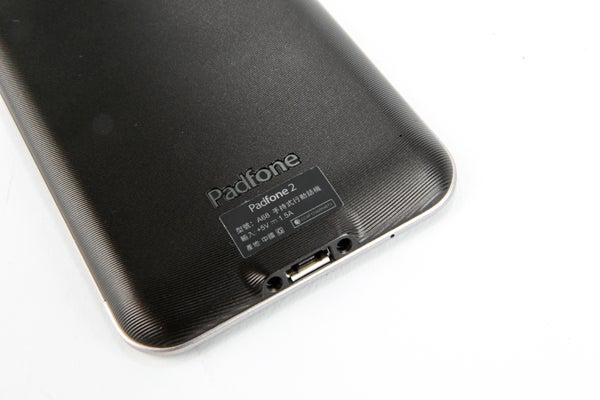
Station
Unlike the Asus Padfone 2’s phone part, the tablet is quite traditionally styled. A 2cm black bezel surrounds the screen, which houses a 1.2-megapixel front facing camera. The volume rocker and speaker grille are situated on the right of the tablet, while the power button sits on the top left. A microUSB charging socket sits on the bottom edge.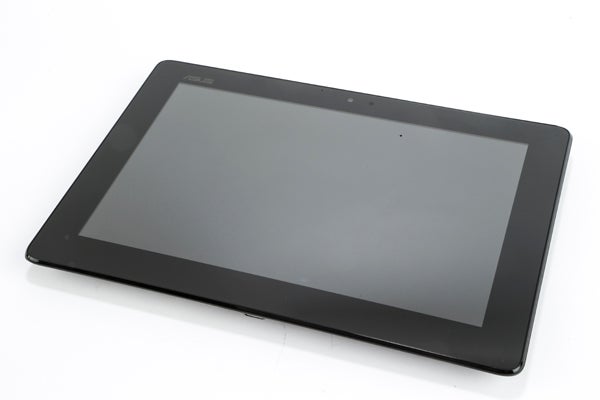
The back is covered in soft touch plastic, which doesn’t feel as premium as some other tablets. The back also houses the Asus Padfone 2’s phone socket. This is a cradle and dock that the phone slots into. It connects with a satisfying clunk and feels very secure once in. There’s no chance the phone will accidently fall out.
Unfortunately having to fit a whole phone inside it makes the Padfone 2 tablet a bit lumpy. Odd ridges and ledges make a bit of a mess of the design, although the tablet does a good job if you’re more interested in function over form. The docked phone doesn’t get in the way of holding the tablet in landscape or portrait mode and it’s actually slightly lighter than an iPad 4.
Asus Padfone 2 –Screen and speakers
The Padfone 2 phone has a 1,280 x 720 IPS screenswhile the tablet has 1,280 x 800 resolution. Due to the difference in screen sizes however their pixel densities are very different. The phone is a reasonable 312 PPI, while the tablet has to make do with a measly 149 PPI.
Phone
The Asus Padfone 2’s phone screen is very good. It may not have the full HD resolution of the latest new phones, such as the Sony Xperia Z, HTC One and Samsung Galaxy S4 but the resolution is more than adequate for all but the pickiest.
Where the Asus’s screen excels is with its rich and deep colours. It manages to provide these without looking oversaturated, and avoids the unpleasant colour tones of some AMOLED screens. If there’s one tiny grumble it’s that the blacks aren’t as deep as those found on OLED displays like the stunning display of the Samsung Galaxy S4.
The scratch resistant corning glass is obligatory these days but the Padfone 2’s phone also has an oleophobic (grease resistant, to you and me) layer. This isn’t a miracle layer, and if you’re tucking into a bucket of KFC while using the phone it will get greasy. However, it resisted fingerprints better than most other phones we’ve tested.
We are also impressed by the maximum volume of the internal speaker. The sound quality at the loudest volumes isn’t great but it’s more than possible to watch a film or listen to some slightly tinny music with company.
Station
It was always going to be difficult for the tablet to live up to the phone’s screen but, unfortunately, it doesn’t even live up to most decent tablets on the market either. The 1,280 x 800 resolution looks sharp on another Asus built tablet, the Google Nexus 7, but that’s on a much more forgiving 7-inch screen. On a 10.1-inch device this resolution doesn’t cut it. 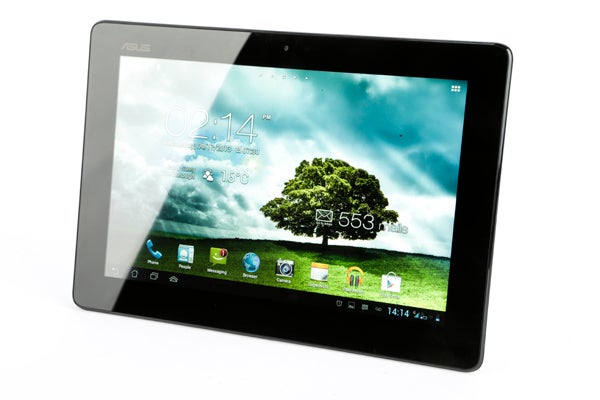
The main gripe is that the Padfone 2’s screen is not quite as sharp as it should be and its colours are slightly anaemic. In addition the anti-fingerprint coating on the tablet doesn’t work quite as well as it does on the phone. You’ll quickly find a crisscross of smears all over the screen.
Watching video is a perfectly acceptable experience. 720p footage looks detailed, if a little drab. The main problems arise when web browsing or reading text. Fonts are a little fuzzy around the edges and you’ll notice it even more if you’ve ever used a sharper-screened tablet like the iPad 4 or Nexus 10.
We’d much prefer it if the Padfone 2 Station had a higher res display. A full HD screen would make a huge difference and it’s a bit of a mystery why Asus has decided to cut corners here, other than to keep costs down. The Padfone 2’s bigger brother, the Padfone Infinity, is able to switch between 1,920 x 1,080 for the phone to 1,920 x 1,200 for the tablet, so it’s not because of any technical limitation. 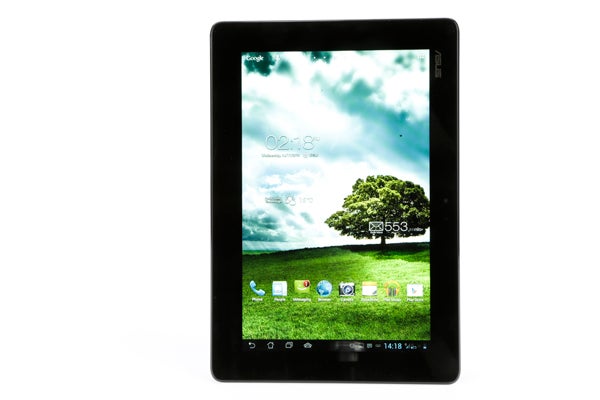
Screen disappointment aside, docking the phone into the tablet provides a seamless transition from small screen to big. It takes just a second to switch over and Asus has cleverly tweaked the Android OS to recognise when you’re in tablet mode, altering the layout accordingly.
It’s a pleasingly intuitive feature and, if you do happen to get a call, the tablet also works as a hands free phone so you don’t actually need to remove the phone form the cradle to answer.
Once again the mono speaker is all about being loud, but behaves better at its highest volume than the one in the phone. It’s a little disappointing that the Padfone 2 Station doesn’t possess stereo speakers, which have become the norm in 10.1-inch tablets. Go to the next page to see how the Padfone 2 does in terms of features.
Asus Padfone 2 – Performance and Call Quality
With a quad-core Snapdragon S4 Pro processor clocked at 1.5GHz running the show, the Asus Padfone 2 is quick. Couple this with 2GB RAM and an Adreno 320 graphics chip and you have almost exactly the same specs as Sony’s impressive flagship phone, the Xperia Z.
The Asus Padfone 2 performs well when compared to the Galaxy S3 and Nexus 4. It scores around 20 per cent better than these phones when we put it through our benchmark tests. In practice this means that it doesn’t even break a sweat playing even the most demanding of games. Real Racing 3, for example, looks stunning and performs well while multitasking, and 720p video is no problem at all. 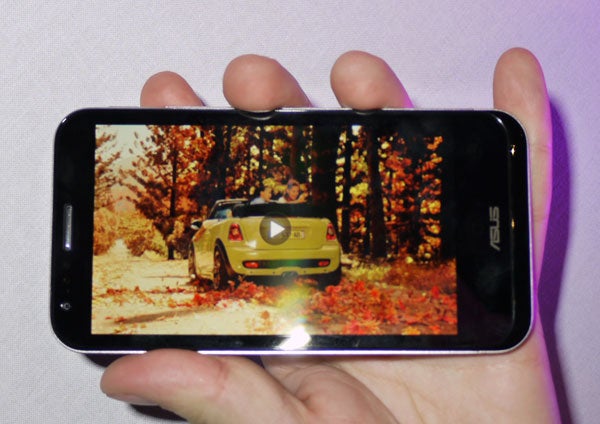
It’s easy to ignore call quality on phones these days. Making calls is almost seen as a secondary function, but it is still important. We found that the Padfone 2 performed perfectly well when both making and receiving calls.
Whack the volume up on the ear speaker and you’ll be able to hear what the person on the other end of the line is saying even in a noisy environment. The microphone is also solid and manages to provide clear sound both on calls and while recording audio.
Benchmarks:
• Antutu 3.3 – CPU 8563 – RAM 3469 – GPU 8607 – I/0 897 – Total: 21536
• Sunspider – 1925ms
Asus Padfone 2 – Connectivity
It’s almost as if Asus decided to remove every piece of connectivity possible from both phone and station. Aside from docking the phone to the station the only other physical connections are a microUSB on the phone and a matching microUSB on the Station. All other connectivity comes in wireless form – NFC, Bluetooth, GPS, 4G and, of course, Wi-Fi.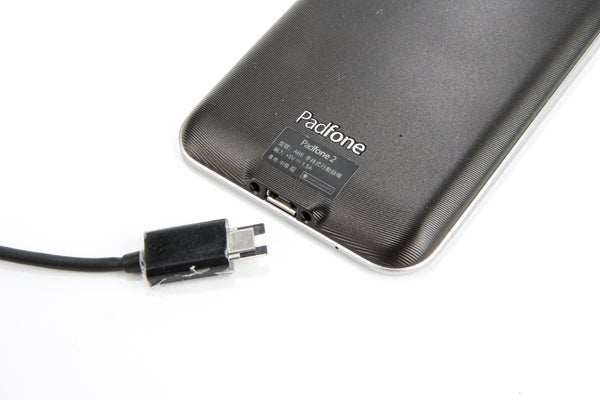
There’s no HDMI out, which won’t matter to most, but surprisingly the Padfone 2 also lacks a microSD card slot. Many phones these days are leaving this feature out but it seems a very odd choice for a device trying to be a phone and tablet at the same time.
If you have a discrete tablet and phone you have two sets of storage, one on the phone and one on the tablet. Asus does provide every buyer with 50GB of online storage for free but this hardly makes up for the omission. On the plus side the Padfone 2 does come in a 64GB version which should be plenty for many users, but at £600 the extra storage comes at a premium. The 16GB version can be bought for £470 and the 32GB costs around £500. 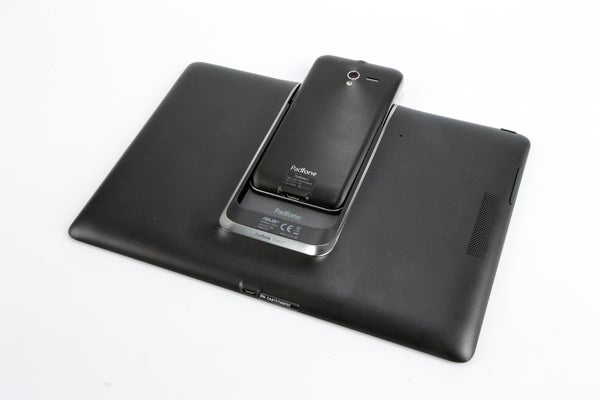
One of the benefits of being a hybrid device is that you end up with a 3G/4G ready 10.1-inch tablet. If you absolutely need a tablet with a 3G connection then Padfone 2 is actually quite cost effective in the long terms as you don’t require two 3G contracts. This is only useful, though, if you intend to take your tablet outside the house.
Asus Padfone 2 – Cameras
Asus has certainly not scrimped on camera specs. The Padfone 2 comes with a 13-megapixel rear facing camera and dual 1.2-megapixel front-facing cameras (one for the phone and one for the Station), which are primarily meant for video calling.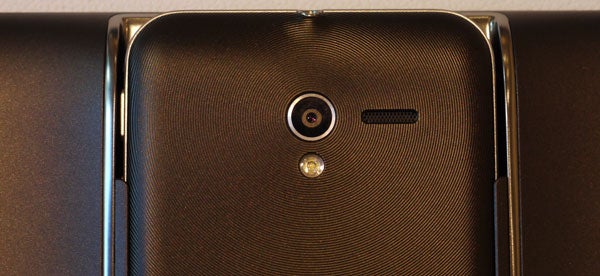
The app that controls the camera has had a big overhaul since the first Padfone and offers a number of useful features such as camera effects, panorama, scenes and HDR. This makes taking photos a rich experience, you can tweak setting to your heart’s content. Unfortunately the 13-megapixel rear camera really struggles in low light conditions and pictures can be very noisy in anything but perfect conditions.
Another issue is that the colours are a bit muted and there appears to be some heavy post-processing affecting the picture quality. For example the shot of the Shard, below, was taken in good conditions yet the colours are drab and the photo is very flat. 
Our dark store cupboard was lit up well by the LED flash, but once again the high resolution sensor struggles with noise. 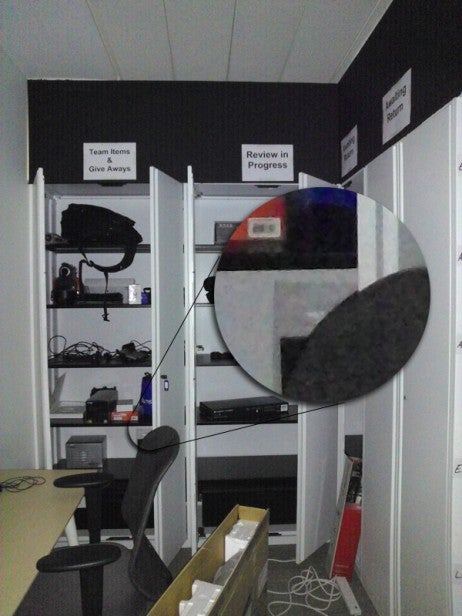
Aside from pictures the camera can shoot video at 720p at 60fps and at 1080p at 30fps. Video quality is adequate for a phone but again the camera can’t reproduce colours accurately. The front facing camera, on the other hand, do a fine job of sending video over Skype.
Asus Padfone – Software
The Padfone 2 runs Android 4.1 Jelly Bean. This isn’t the latest version of the Android operating system, but it is just one update off. Plans have been announced for an update to 4.2 in the near future.
The Android experience you get on the Padfone 2 is quite “stock”. Asus has added a few features that improve the experience, though. One is a Wi-Fi switching service that automatically connects to the strongest connection you’ve stored. Audio Wizard, on the other hand, lets you pick from five presets that Asus claim provide a more natural sound, whether you’re watching a movie, listening to music, talking or gaming.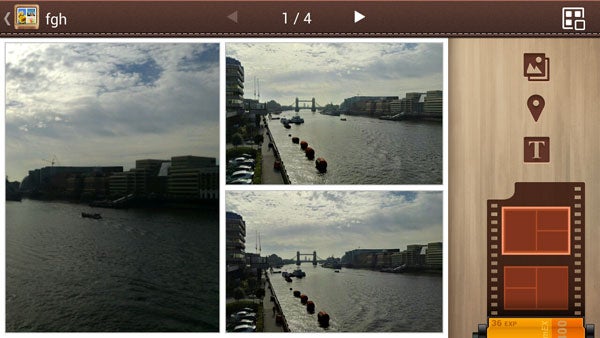
There are also two picture apps exclusive to Asus. The first is called Asus Studio, essentially a slicker version of the normal Android gallery. The second is called Asus Story. This lets you stitch together photos and text into little presentations. Both these features are intuitive and fun to use, but Story did crash on us a few times.
Asus Padfone 2 – Battery life
One area where the Padfone 2 excels is battery life. The phone has a 2140mAh battery, which provides enough stamina for it to last for more than a day with moderate use off a charge. This compares favourably to competitors such as the HTC One and Xperia Z, both of which struggle to last a full day.
We managed to get a little less than eight hours of constant video play with Wi-Fi streaming from the phone and almost exactly the same for the 5000mAh for the Padfone 2 Station. The Station basically doubles the phone’s battery life. 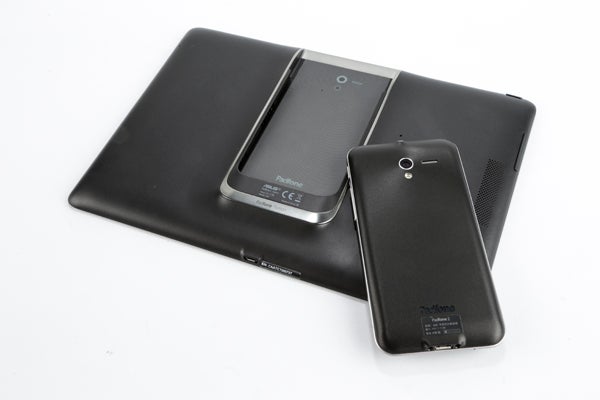
Asus Padfone 2 – Value
It’s hard to defend the Padfone 2 in terms of value. At £600 it costs only slightly less than you’d spend on a 16GB Google Nexus 4 and a 32GB Nexus 10 combined. While the phones are comparable in terms of performance, the Nexus 10 wipes the floor with the Padfone 2 in terms of a tablet experience. Alternatively you can get the recently released Sony Xperia Z, with its full HD screen, microSD card slot and waterproofing and still have money left over for a 16GB Nexus 7 to use as a tablet. The other option is to buy a Samsung Galaxy S3 with a… you get the picture.
The options are almost endless and most provide a better overall experience than the Padfone 2, and allow more than one person to use the phone/tablet at the same time. If you find the Padfone 2 going for a song or you desperately need a 3G 10.1 inch tablet without paying a premium for it then the Padfone 2 is worth considering, otherwise niche users only need apply.
Verdict
The Asus Padfone 2 is a difficult device to dislike because it’s interesting and innovative, but it is also a difficult to defend. The idea of it makes sense on paper and there is a very capable, well-built phone coupled with a functional, if average, tablet. The problem is that it comes at a hefty premium and only one person can use the device at a time.
If the Padfone 2 provided a perfect phone and tablet experience we might be more forgiving of the lack of microSD card slot. However, as it stands, there’s very little to recommend this over practically any other tablet and phone combination at the price.
How we test phones
We test every mobile phone we review thoroughly. We use industry standard tests to compare features properly and we use the phone as our main device over the review period. We’ll always tell you what we find and we never, ever, accept money to review a product.
Trusted Score
Score in detail
-
Performance 8
-
Camera 7
-
Design 7
-
Usability 9
-
Value 4
-
Features 7
-
Screen Quality 7


